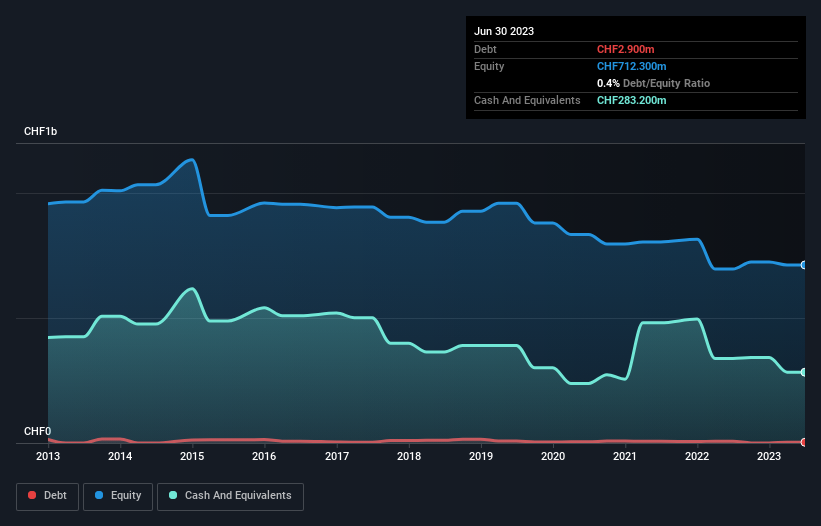
The external fund manager backed by Berkshire Hathaway's Charlie Munger, Li Lu, makes no bones about it when he says 'The biggest investment risk is not the volatility of prices, but whether you will suffer a permanent loss of capital.' So it seems the smart money knows that debt - which is usually involved in bankruptcies - is a very important factor, when you assess how risky a company is. As with many other companies Bystronic AG (VTX:BYS) makes use of debt. But is this debt a concern to shareholders?
When Is Debt A Problem?
Debt assists a business until the business has trouble paying it off, either with new capital or with free cash flow. If things get really bad, the lenders can take control of the business. While that is not too common, we often do see indebted companies permanently diluting shareholders because lenders force them to raise capital at a distressed price. Of course, debt can be an important tool in businesses, particularly capital heavy businesses. When we examine debt levels, we first consider both cash and debt levels, together.
Check out our latest analysis for Bystronic
What Is Bystronic's Debt?
The image below, which you can click on for greater detail, shows that Bystronic had debt of CHF2.90m at the end of June 2023, a reduction from CHF7.20m over a year. But on the other hand it also has CHF283.2m in cash, leading to a CHF280.3m net cash position.

A Look At Bystronic's Liabilities
The latest balance sheet data shows that Bystronic had liabilities of CHF351.3m due within a year, and liabilities of CHF40.2m falling due after that. Offsetting this, it had CHF283.2m in cash and CHF211.4m in receivables that were due within 12 months. So it can boast CHF103.1m more liquid assets than total liabilities.
This short term liquidity is a sign that Bystronic could probably pay off its debt with ease, as its balance sheet is far from stretched. Succinctly put, Bystronic boasts net cash, so it's fair to say it does not have a heavy debt load!
Better yet, Bystronic grew its EBIT by 204% last year, which is an impressive improvement. If maintained that growth will make the debt even more manageable in the years ahead. The balance sheet is clearly the area to focus on when you are analysing debt. But ultimately the future profitability of the business will decide if Bystronic can strengthen its balance sheet over time. So if you want to see what the professionals think, you might find this free report on analyst profit forecasts to be interesting.
Finally, a business needs free cash flow to pay off debt; accounting profits just don't cut it. Bystronic may have net cash on the balance sheet, but it is still interesting to look at how well the business converts its earnings before interest and tax (EBIT) to free cash flow, because that will influence both its need for, and its capacity to manage debt. Looking at the most recent three years, Bystronic recorded free cash flow of 25% of its EBIT, which is weaker than we'd expect. That's not great, when it comes to paying down debt.
Summing Up
While it is always sensible to investigate a company's debt, in this case Bystronic has CHF280.3m in net cash and a decent-looking balance sheet. And we liked the look of last year's 204% year-on-year EBIT growth. So is Bystronic's debt a risk? It doesn't seem so to us. There's no doubt that we learn most about debt from the balance sheet. However, not all investment risk resides within the balance sheet - far from it. These risks can be hard to spot. Every company has them, and we've spotted 3 warning signs for Bystronic you should know about.
At the end of the day, it's often better to focus on companies that are free from net debt. You can access our special list of such companies (all with a track record of profit growth). It's free.
Valuation is complex, but we're here to simplify it.
Discover if Bystronic might be undervalued or overvalued with our detailed analysis, featuring fair value estimates, potential risks, dividends, insider trades, and its financial condition.
Access Free AnalysisHave feedback on this article? Concerned about the content? Get in touch with us directly. Alternatively, email editorial-team (at) simplywallst.com.
This article by Simply Wall St is general in nature. We provide commentary based on historical data and analyst forecasts only using an unbiased methodology and our articles are not intended to be financial advice. It does not constitute a recommendation to buy or sell any stock, and does not take account of your objectives, or your financial situation. We aim to bring you long-term focused analysis driven by fundamental data. Note that our analysis may not factor in the latest price-sensitive company announcements or qualitative material. Simply Wall St has no position in any stocks mentioned.
About SWX:BYS
Bystronic
Through its subsidiaries, engages in the provision of sheet metal processing solutions for cutting, bending, and automation worldwide.
Flawless balance sheet and undervalued.
Market Insights
Community Narratives



